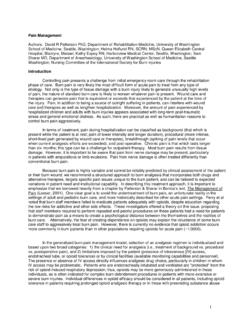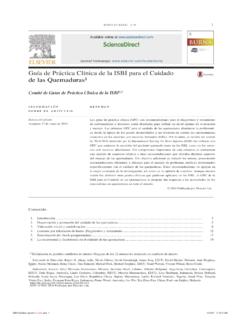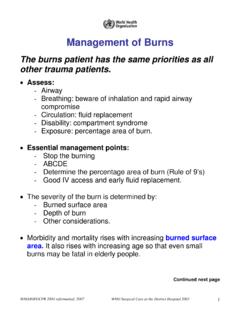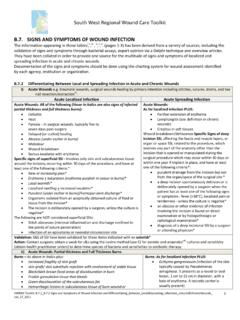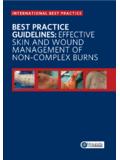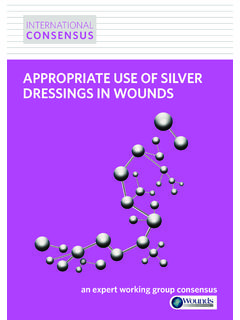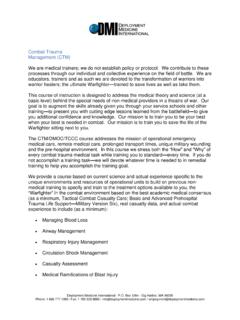Transcription of BURN WOUND CARE - world burn
1 care OF burn PATIENTS IN THE HOSPITAL. Sheila Kavanagh OAM, RN, RM, Bnurs, Royal Adelaide Hospital, Adelaide, Australia; Alette de Jong RN, MSc, Rode Kruis Ziekenhuis, Beverwijk, The Netherlands; Nursing Committee of the International Society for burn Injuries Introduction In caring for the patient with a burn injury it is important to remember that many factors impact on the care that we are able to deliver. This is of particular relevance in the area of WOUND care . Access to costly WOUND products is not an option in many settings. In these situations, creativity and innovation have led to many excellent alternatives being developed. In some instances sophisticated products are available but lack of clinical experience makes them difficult to use.
2 WOUND care needs to be undertaken in the context of the local environment. THE burn WOUND . It is appropriate to highlight the functions of the skin as they underpin the management of the burn WOUND : Protection Immunological Fluid, protein and electrolyte homeostasis Thermoregulation Neurosensory Social interactive Metabolism A burn injury results in either the loss or disruption of some or all of these functions. The burns nurse must assess all of these factors when deciding on an appropriate nursing management plan. Thermal energy effects The three mechanisms that energy transfers by, are conduction, convection and radiation. All of these mechanisms affecting heat transfer may deliver heat to, or away from, living 1.
3 Tissues. 1. Sustained temperatures result in cellular dysfunction and early denaturation of protein. As the temperature or the time of exposure increases, then cell damage increases. 2. Nguyen, Gun, Sparnon and Ryan concur with other studies in demonstrating the beneficial effects of cooling on reducing tissue damage and WOUND healing time. The question often asked, is how long after the burn injury, is it still worthwhile to commence 2. cooling. Nguyen et al conclude from various authors that although immediate cooling is preferable, even a 30 minute delay in application of cooling is still beneficial to the burn 1. WOUND . The same authors do point out that the application of cooling 60 minutes after injury, does not demonstrate any benefit.
4 Impairment of blood flow in the zone of stasis can occur from shortly after the burn injury up 1. to 48 hours post- burn . If blood flow is compromised, this may lead to the eventual necrosis of cells in this zone. Clinical management that will promote the recovery of this zone includes: WOUND dressing chosen to aid moist WOUND healing The use of topical antimicrobial agents Adequate fluid resuscitation / hydration Elevation of burnt area to minimise oedema Advising patient to avoid / minimise smoking Management of systemic diseases such as diabetes monitor & stabilise blood sugar levels. burn WOUND oedema It is important to have an understanding of the timeframe of oedema development and resolution.
5 The ability of the tissues to receive oxygen and nutrients is reduced during this 1. time, while susceptibility to infection is increased. The impact of this on clinical management is that strategies to aid recovery of the zone of stasis must extend until oedema resolution has occurred. burn inflammation Inflammation becomes prominent at 7-10 days post injury. It is at this time that blood flow in the burn WOUND is at its maximal level. Surgery therefore, may be hazardous due to an increased risk of blood loss. This is one of the reasons that early burn WOUND excision, is 1. favoured by many burn surgeons. burn WOUND depth burn depth in Australia is most frequently described using the following classification system: Epidermal Superficial Dermal Mid-Dermal Deep Dermal Full thickness st nd rd Other classification systems refer to 1 , 2 and 3 degree injury.
6 This system however is subjected to personal interpretation of the classification. The advantage of the descriptive system is that it removes any ambiguity. This is especially useful when discussing burn WOUND management over the phone. 2. The burn blister This is a subject still debated at length by various practitioners. A review of the literature by 3. Flanangan & Graham led them to conclude that' empirical evidence over the last 50 years 1. both supports and refutes the routine debridement of blisters'. Authors such as Williams , 4 5. Pankhurst and Pochkhanawala and Carrougher conclude that small blisters can be let intact, but as a general rule, blisters should be debrided and the WOUND dressed.
7 How this translates into clinical practice is based on treating every patient individually. A. variety of factors should be taken into consideration when deciding wether to de-roof blisters or leave them intact. In the paediatric setting, blisters on the palm of the hand and sole of the foot are often left intact for a period of 48hours. In the adult, large blisters on the palm of the hand may impede function to a level that is unacceptable. It has already been mentioned that the size of the blister should be taken into consideration. Factors affecting WOUND healing Both the very young and the elderly have very thin skin that makes them more susceptible to significant burn injury Other factors that affect WOUND healing include: Nutrition Infection Associated illnesses such as diabetes mellitus, malignancy and vascular insufficiency Cytotoxic treatments burn WOUND healing Factors that will enable healing to occur include WOUND care , good nutrition, maintenance of function, positive attitude and co-operation from the patient.
8 Oedema reduction, prevention of burn WOUND infection and adequate analgesia will also contribute to optimal patient outcome. The achievement of these goals involves the whole burn team, Every team member has a responsibility to maintain a high standard in relation to infection control strategies. care of the WOUND itself should be designed to: Promote spontaneous healing Prevent further tissue loss Prevent infection Provide optimal conditions for surgery if required Be as painless as possible 3. Be acceptable to the patients needs WOUND cleansing It is interesting to note that in the general WOUND care arena, there has been much discussion on the choice of WOUND cleansing solutions.
9 Most studies have not looked at burn wounds. The Joanna Briggs Institute Best Practice information sheet Solutions, techniques 6. and pressure for WOUND cleansing' excluded studies that compared solutions for patients with burns. 5 4. Many authors including Carrougher , and Pankhurst & Pochkhanawala , report that in practice most burns units bath or shower their patients with tap water. Some centres use mild antiseptic impregnated sponges. Extreme caution should be exercised when using solutions that have been shown to be toxic to cells. The maintenance of the temperature of the burn WOUND has been identified as beneficial by numerous authors. Methods of achieving this include: Warming cleansing solutions Warm ambient temperature Avoid lengthy dressing changes Avoid exposure of wet WOUND surfaces Ambulant patients, with minimal WOUND care needs, use independent showering.
10 Burns units may use burn baths, portable shower trolleys, or a combination of both in their management of patients. The burns nurse will need to decide which is the most appropriate choice. Factors that need to be taken into consideration include: Age of patient Patient ability to lie still Extent of open burn WOUND Presence of WOUND infection Available equipment Available space Patients need for physical therapy Wounds or dressings that may benefit from soaking 7. Konop states that the disadvantages of hydrotherapy include the risks of auto- 5. contamination and electrolyte imbalance. Carrougher warns against excessive immersion times over 30 minutes that may cause sodium and heat loss, in addition to pain and anxiety associated with prolonged exposure.
